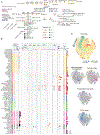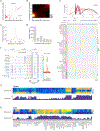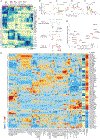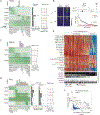The cis-Regulatory Atlas of the Mouse Immune System
- PMID: 30686579
- PMCID: PMC6785993
- DOI: 10.1016/j.cell.2018.12.036
The cis-Regulatory Atlas of the Mouse Immune System
Abstract
A complete chart of cis-regulatory elements and their dynamic activity is necessary to understand the transcriptional basis of differentiation and function of an organ system. We generated matched epigenome and transcriptome measurements in 86 primary cell types that span the mouse immune system and its differentiation cascades. This breadth of data enable variance components analysis that suggests that genes fall into two distinct classes, controlled by either enhancer- or promoter-driven logic, and multiple regression that connects genes to the enhancers that regulate them. Relating transcription factor (TF) expression to the genome-wide accessibility of their binding motifs classifies them as predominantly openers or closers of local chromatin accessibility, pinpointing specific cis-regulatory elements where binding of given TFs is likely functionally relevant, validated by chromatin immunoprecipitation sequencing (ChIP-seq). Overall, this cis-regulatory atlas provides a trove of information on transcriptional regulation through immune differentiation and a foundational scaffold to define key regulatory events throughout the immunological genome.
Keywords: ATAC-seq; Transcriptional regulation; chromatin; enhancer; epigenomics; immune cell differentiation; transcription factor.
Copyright © 2018 Elsevier Inc. All rights reserved.
Figures







Similar articles
-
Profiling of chromatin accessibility and identification of general cis-regulatory mechanisms that control two ocular lens differentiation pathways.Epigenetics Chromatin. 2019 May 3;12(1):27. doi: 10.1186/s13072-019-0272-y. Epigenetics Chromatin. 2019. PMID: 31053165 Free PMC article.
-
Modeling gene regulation from paired expression and chromatin accessibility data.Proc Natl Acad Sci U S A. 2017 Jun 20;114(25):E4914-E4923. doi: 10.1073/pnas.1704553114. Epub 2017 Jun 2. Proc Natl Acad Sci U S A. 2017. PMID: 28576882 Free PMC article.
-
A microRNA expression and regulatory element activity atlas of the mouse immune system.Nat Immunol. 2021 Jul;22(7):914-927. doi: 10.1038/s41590-021-00944-y. Epub 2021 Jun 7. Nat Immunol. 2021. PMID: 34099919 Free PMC article.
-
Beyond the ENCODE project: using genomics and epigenomics strategies to study enhancer evolution.Philos Trans R Soc Lond B Biol Sci. 2013 Nov 11;368(1632):20130022. doi: 10.1098/rstb.2013.0022. Print 2013 Dec 19. Philos Trans R Soc Lond B Biol Sci. 2013. PMID: 24218635 Free PMC article. Review.
-
ChIP-Seq Data Analysis to Define Transcriptional Regulatory Networks.Adv Biochem Eng Biotechnol. 2017;160:1-14. doi: 10.1007/10_2016_43. Adv Biochem Eng Biotechnol. 2017. PMID: 28070596 Review.
Cited by
-
Transcriptional network dynamics in early T cell development.J Exp Med. 2024 Oct 7;221(10):e20230893. doi: 10.1084/jem.20230893. Epub 2024 Aug 21. J Exp Med. 2024. PMID: 39167073 Free PMC article. Review.
-
Defining solute carrier transporter signatures of murine immune cell subsets.Front Immunol. 2023 Nov 24;14:1276196. doi: 10.3389/fimmu.2023.1276196. eCollection 2023. Front Immunol. 2023. PMID: 38077407 Free PMC article.
-
Whole-genome profiling of DNA methylation and hydroxymethylation identifies distinct regulatory programs among innate lymphocytes.Nat Immunol. 2022 Apr;23(4):619-631. doi: 10.1038/s41590-022-01164-8. Epub 2022 Mar 24. Nat Immunol. 2022. PMID: 35332328 Free PMC article.
-
Assessment of computational methods for the analysis of single-cell ATAC-seq data.Genome Biol. 2019 Nov 18;20(1):241. doi: 10.1186/s13059-019-1854-5. Genome Biol. 2019. PMID: 31739806 Free PMC article.
-
Mapping chromatin modifications at the single cell level.Development. 2019 Jun 27;146(12):dev170217. doi: 10.1242/dev.170217. Development. 2019. PMID: 31249006 Free PMC article. Review.
References
-
- Anscombe FJ (1948). The Transformation of Poisson, Binomial and Negative-Binomial Data. Biometrika 35, 246–254.
-
- Bahr C, von Paleske L, Uslu VV, Remeseiro S, Takayama N, Ng SW, Murison A, Langenfeld K, Petretich M, Scognamiglio R, et al. (2018). A Myc enhancer cluster regulates normal and leukaemic haematopoietic stem cell hierarchies. Nature 553, 515–520. - PubMed
-
- Banerji J, Rusconi S, and Schaffner W (1981). Expression of a beta-globin gene is enhanced by remote SV40 DNA sequences. Cell 27, 299–308. - PubMed
-
- Benoist C, and Chambon P (1981). In vivo sequence requirements of the SV40 early promotor region. Nature 290, 304–310. - PubMed
Publication types
MeSH terms
Substances
Grants and funding
LinkOut - more resources
Full Text Sources
Other Literature Sources
Medical
Molecular Biology Databases
Miscellaneous

